The Orgill Brothers of Rough Park
In the early 1800s two brothers, Thomas and William Orgill, came from Burton-upon-Trent to Hamstall Ridware and both became tenant farmers on Lord Leigh’s estate; Thomas at Rough Park and William at Bancroft Farm.
Thomas and his wife, Elizabeth (née Bladon/Bladen), already had two young children when they arrived c.1815 and over the next 20 years they added to their brood with nine more. As young adults,five of their sons would leave the rural village of Hamstall Ridware to embark on a new life in ‘the land of opportunity’, the fledgling United States of America. Three of them made the name Orgill one that endures to this day, especially on the American continent. It is a name synonymous with the hardware business.
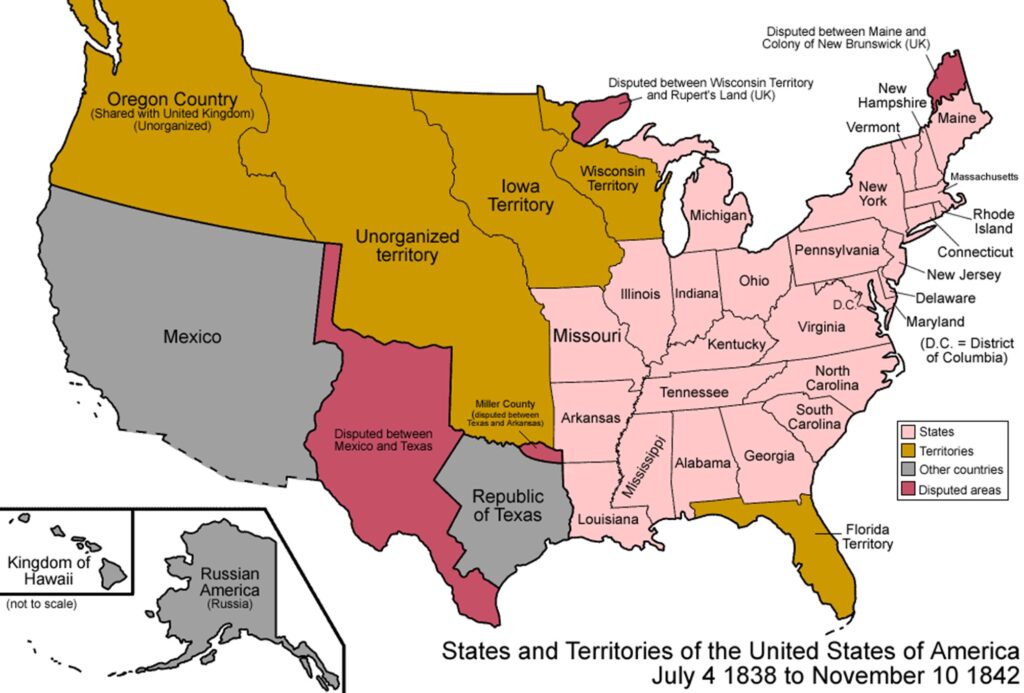
Made by User: Golbez., CC BY-SA 3.0 <http://creativecommons.org/licenses/by-sa/3.0/>, via Wikimedia Commons
This map shows the United States and associated territories as they were about the time of the Orgill brothers’ arrival.
It’s hard to imagine now, in the age of global travel, how or why the notion of embarking on such a perilous journey from the small village of Hamstall Ridware in rural Staffordshire to New York and thence to Memphis, Tennessee, in the early 1840s might have come about, but Joseph, William and Edmund Orgill, were the first of the five to do just that, one in his 30s and the other two in their early 20s. Perhaps the first question should be, why would young men, and in particular, an eldest son, venture forth into the unknown, on what would undoubtedly be a hazardous journey? Maybe because during the late 1830s farming in England had begun to decline, leading to large scale rural unemployment. The 1840s saw years of poor harvests which led to what became known as the ‘Hungry Forties’. For Thomas and Elizabeth Orgill, it was hard enough to feed all those mouths, but there was also the added worry that farming was no longer a reliable option for employment for their sons as they were entering into adulthood. A second answer to the why must have been the lure of America, as the land of good economic prospects. A third reason could have been simply because now they could! The how was made possible from the 1840s onwards, in England by the growth of railways across the country (Stafford station opened in 1837), and the increasing steamship networks operating out of London and Liverpool across the Atlantic to New York or Boston. Those with a pioneering spirit, like the Orgillls, could now access the means to travel to and from the new world with relative ease. Around the same time the invention of the electric telegraph and the introduction of under-sea telegraph cables, meant people in commerce could transmit messages across both continents and oceans almost instantly. This would have been a boon to the Orgill family.
Another question at first seemed to be, why would young men from a farming background become involved in hardware? The answer appears to lie with their father’s family. Thomas Orgill’s mother was Anne Tarratt. Some of her family had moved from Burton-upon-Trent to Wolverhampton c.1790 and inaugurated the business: Joseph Tarratt and Sons of Wolverhampton, Exporters of Guns, Agricultural Hardware etc. It isn’t a huge leap of credulity to suspect that Thomas thought the successful family hardware business could provide better employment opportunities than farming for some of his sons at this time. Added to this was the fact that an entrepreneurial Joseph Tarratt, Ann Orgill’s brother, the young Orgills’ uncle, had been travelling to and from America from 1829 onwards. He had married there and his son, another Joseph, was born there. Joseph Tarratt Snr, established a branch of Tarratt and Sons in New York in 1832. Joseph and William Orgill would probably have heard about opportunities in the US, so it is not too speculative to suppose that they went to join their uncle and cousin.
At the time the older Orgill brothers were ready to embark on their adventures, there were already several sailing vessels in operation on regular routes on regular timetables, carrying mail to and from America and Europe. These ships were known as ‘packet’ ships because mail was known as the ‘packette’. Typically a packet ship was about two hundred feet long, with three masts and a wooden broad-bowed hull that could plough through the worst the North Atlantic storms and rough seas threw at them, with reasonable speed and stability. Due to increased demand for ships to carry people, a packet of the 1830s could also accommodate 10 to 12 well-to-do cabin passengers. In good weather a packet could make 200 miles a day. A voyage would then take about six weeks, but could be 14 or more weeks when the weather was bad. Conditions on board also left much to be desired.
By the late 1830s and early 1840s more reliable steamships were being introduced to the trans-Atlantic routes. They were driven by a screw propeller, but still carried sail as back-up. They began to attract lucrative cargoes and wealthy passengers, leaving the sailing vessels to people who could not afford such luxury! As the Orgills travelled ‘cabin class’ they must have been relatively well off. This afforded them the ‘comfort’ of sleeping in private or semi-private rooms.
Steam power promised to free ocean-going vessels from the vagaries of wind and weather. Still, steamships suffered from a variety of problems of their own: carrying enough fuel, finding reliable engines, and supporting the huge operating costs as well as problems that had been faced previously, such as disease. However, with favourable conditions a journey could now take as little as 14 days. Progress indeed.
There seems to be some uncertainty over whether any of the Orgill brothers embarked on their journeys at the same time or whether William or Joseph went first. One document suggests that they came together. An article published in the 1918 Southern Hardware and Implement Journal stated that:
It was in the early [eighteen] forties that two young men, – Joseph and William Orgill – came over from England and established themselves in New York City as representatives of the leading British [hardware] manufacturers and act as importers.
The second document, an account written in the Memphis Commercial Appeal on its 175th anniversary in 2016, stated that: ‘William Orgill came from England to join his brother, Joseph, as a travelling salesman for his importing company in New York.’ This implies that Joseph had emigrated first and already set up a trading business. Thus far it has not been possible to determine which is most accurate.
The earliest passenger manifest found for either brother is for William Orgill aboard the SS United States. He left Liverpool on 1 November 1841 and arrived in New York 11 January 1842, a journey of about 10 weeks. He was just 20. His occupation was cited as merchant.
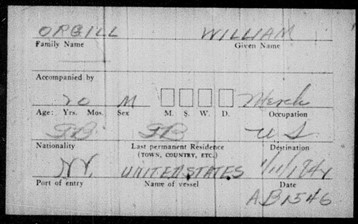
SS United States Boarding Card for William Orgill November 1 1841
The earliest evidence of Joseph’s travel found so far is in June 1851 aboard the SS Victoria when he was 39. His occupation is recorded as farmer. This and the fact that he is enumerated on the 1851 March census for Hamstall Ridware, occupation farmer (retired), also gives cause to question an earlier arrival timeline. However, it is possible that the manifest for a ship on which Joseph might have been travelling is just not available or has been lost. It is also possible that Joseph had returned home from America for a family or business visit, as he and his brothers continued to do over a period of the next 50 or 60 years, and he just happened to be in England at the time of the 1851 census. Their younger brother Edmund, aged about 24, sailed from Liverpool for Boston, Massachusetts aboard the SS America in 1849, which also appears to pre-date Joseph’s arrival. On balance though, it makes sense that Joseph, being the eldest by some ten years, arrived first and had established himself in New York and that William and then Edmund had a base to operate from when they arrived.
Putting those uncertainties to one side, what is not in question is that a hardware business in America, now known as Orgill, Inc., was established by the brothers from Staffordshire, England and is now Memphis’s oldest and longest running independent business.
It was William who had the pioneering spirit and business acumen. A newspaper report, written in 1883, when the Orgill Company was three decades old, with the headline, ‘Orgill Brothers & Co., Hardware Stores, Tinware, Agricultural Goods and Machinery’, stated: The earliest pages of history of an eventful city like Memphis, should naturally be reserved for some account of the pioneers of its commerce, who have been the founders of its greatness…But its superior location as a business point, was quickly seen and appreciated by sagacious merchants who recognized its grand possibilities as a trade center…By far the greatest portion of these enterprising spirits now peacefully rest in another land, but they left here enduring monuments to their judgement…self-denial and energy. Chief among this band were the founders of the celebrated house whose name appears at the citation of this article
In the 1840s there was little American-made hardware, so it was necessary to import practically all the cutlery, agricultural tools, guns and other hardware articles that a pioneer town would need from Europe. This merchandise came by way of steamers to New Orleans and then up river to Memphis, Tennessee. During William’s frequent business travels along the eastern coast of the United States, he learned of a hardware business in Petersburg, Virginia which was for sale, so with an eye to the future, in 1846 he purchased the inventory. As a travelling salesman William also got to know the Mississippi Valley very well and so impressed was he with the possibilities of Memphis as a trading centre, that in 1847 when the city wasn’t yet 30 years old with a population of only 7,000, he moved his newly acquired hardware stock from Petersburg to Memphis. According to Clark Porteous’ book, The First Orgill Century: 1847-1947, ‘the goods were transported by boat down the James River to the Atlantic Ocean, through the Gulf of Mexico to New Orleans and up the Mississippi River’. In Memphis he joined in partnership with the firm of R.T. Lamb & Co. Together they had the largest hardware stock south of the Ohio River. Under William’s management the business began to flourish and Thomas Holyoake and Henry Lownes (names that were to be remembered by the Orgill family in Hill Ridware) became members of the company. When Robert T. Lamb died in 1849, the company was renamed Holyoake, Lownes and Company. They stamped their authority in the area by erecting a brick building which was considered one of the finest in the city and was a well-known landmark for over 100 years.
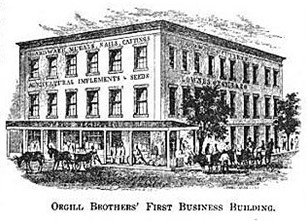
Front Street, Memphis, Tennessee
Back in England, in 1843 at the age of 18, Edmund, William and Joseph’s younger brother, had embarked on his business career in a bank in Burton-upon-Trent. Six years later he too embarked on the perilous journey to America. Having arrived in Boston aboard the steamship SS America in September 1849, Edmund made his way to New York and joined a hardware company which had been founded in 1848, by the name of Wiebusch and Sons. They traded in small hardware goods such as carpenters’ tools and agricultural small wares like scythes and grass hooks. By this time William had moved to Memphis. Edmund’s obituary of 1905 stated that, ‘In 1849 when he first came to this country, he joined his brother in the wholesale hardware business in New York City, representing at the same time the firm of Joseph Tarratt & Son, Wolverhampton, England, who were very large exporters of Hardware, Guns, etc.’ Frustratingly it did not say which brother! In 1850 William Orgill must have visited home and on his return journey in August aboard the newly launched steamship City of Glasgow, he was accompanied by his two youngest brothers, Frederick who was 22, and Arthur who was 16. Not much is known about Frederick and Arthur’s time in America nor how or if they were involved with William’s company in Memphis. It seems most likely that they were associated with Joseph’s importing business as they are both recorded in American city trade directories with Joseph at his address in Brooklyn, New York. Frederick made at least one more journey to England and returned to America, aboard the USM Baltic in August 1855, when his occupation was listed as merchant. This time he accompanied his eldest brother Joseph and youngest brother Arthur. Frederick died in Brooklyn in 1859 aged 31.
The 1850s were an important decade for Memphis, initially because of its river trade and then in 1857 with the advent of railroad connections. These linked the city to the rest of the South, providing a new avenue for shipments. It rapidly developed as a trading centre for cotton cultivated at the region’s larger plantations, which were dependant on the work of enslaved African Americans. This ensured the growth of the Orgill enterprise, but tensions about slavery were hastening the nation towards civil war.
William made a number of journeys to and from England in his capacity as a trading merchant. In 1852 on one of his visits, he married Hannah Turner and when they returned to America they lived in Brooklyn, New York for about 16 years. They both returned to England, perhaps to attend the marriage of William’s youngest sister, Elizabeth, in September 1863, remaining until February 1864 when their first son, William Lownes Orgill, was born. He was baptised in Mavesyn Ridware. However when their second son Edgar Holyoake Orgill was born in 1867 they were back in Brooklyn, New York. Both sons were given middle names, namely Lownes and Holyoake, which were closely linked to the Orgill Company.
In 1854 Edmund Orgill married Lucy Willins in Brooklyn, New York. Her family had emigrated there from Warwickshire c.1836. Her father, John, was an upholsterer.
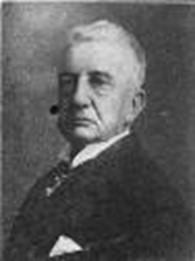
Edmund Orgill Snr. 1825 – 1905
Shortly after their marriage Edmund and Lucy moved to Memphis and Edmund purchased a share and became a partner in his brother William’s business, which became known as Lownes, Orgill and Company. In 1859 when Mr Lownes retired, Edmund became the majority holder and was the first Orgill to head the company publicly. The company’s name changed yet again to Orgill Brothers & Co. He was the company’s president from 1897 until his death in 1905.
The 1860s was another pivotal decade for the fortunes of the Orgill hardware company, largely due to the American Civil War. In June 1861 Tennessee seceded from the United States and Memphis briefly became a Confederate stronghold. Union forces captured Memphis from the Confederacy in June 1862. It became a Union supply base and continued to prosper throughout the war, while remaining under Union control.
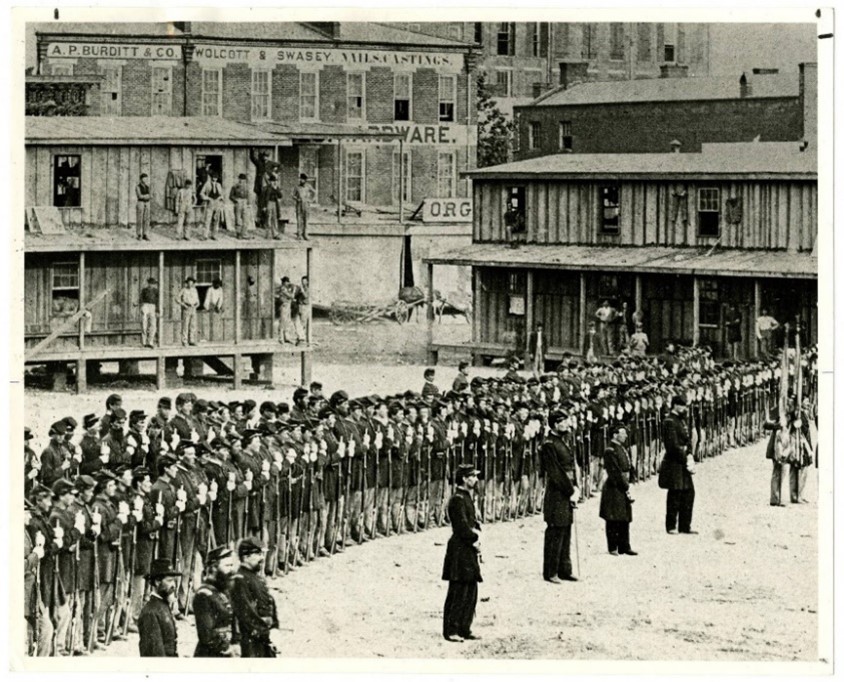
Civil War Union Soldiers parade in Memphis, Tennessee. The Orgill building can be seen in the background.
Orgill Brothers & Co. would have benefited at this time as purveyors of a wide variety of products that were needed by fighting forces. They sold all the accoutrements that an outdoor army kitchen would need, such as sheet iron ‘Shiras’ ovens, bread ovens and a wide range of huge cooking pots, kettles and coffee pots and cutlery that were needed to feed a field army. They also sold the tools such as spades and shovels needed for digging trenches and dugouts; hammers, saws and iron nails that would be needed for fencing and, most importantly, guns. The end of the Civil War in 1865 heralded a second industrial revolution and Orgill Brothers & Co. was able to take full advantage by expanding into more states. Memphis emerged from the Civil War undamaged from the fighting and Tennessee was the first southern state to be re-admitted to the Union in July 1866.

1862 Orgill, Brothers & Co. Billhead
Between 1855 and 1870 Edmund and Lucy had eight children. It was Edmund and his descendants who continued to ‘grow’ the business firstly in Memphis, Tennessee and then to expand into more US states.
William retired from the business after the end of the American Civil War, c.1865, and his brother Edmund’s father-in-law, John Willins, became connected with the firm in Memphis and acted as manager until his death in 1892.
Nothing is known of Arthur’s role, if any in the family business. After his arrival in New York he appears to have returned to England on at least two occasions. In between times he was residing with his older brother Joseph and his occupation was enumerated as merchant on the censuses, so presumably he worked for Joseph rather than in William and Edmund’s company. In 1863 it became necessary for the Federal Government to enrol and draft men into the army. The Conscription Act declared that men between the ages of 20 and 45 were eligible for duty. Aliens who had filed a declaration of intention to become American citizens were also eligible and so in July 1863 Arthur was listed in the Civil War Draft Registration Records in Brooklyn City, New York, but nothing more has been found. He had returned to England in April 1864, on what turned out to be his last visit. In September of that year he married Charlotte Turner, a cousin of his brother, William’s wife, Hannah, in Abbots Bromley. In November, shortly after their marriage, they returned to Brooklyn and on the 1865 census they were living with Joseph. In February 1866 their daughter was born, but in July 1867 Arthur’s death was announced in the Staffordshire Advertiser when he was just 32. Charlotte and her daughter returned to her parents in Abbots Bromley.
William and family returned to England c.1868 and lived for about two years in the Upper House, Hill Ridware and then, up until at least 1891 in Church Street, Rugeley. William continued to ‘commute’ to and from New York until at least 1880. In their later years, he and Hannah spent time with their sons, Edgar Holyoake at Wood Farm, Colton, and William Lownes and family at The Cottage, Hill Ridware. William died in May 1901 and Hannah died in 1904. Both were buried in Mavesyn Ridware.
No more was written in the Orgill Company history or hardware publications about Joseph Orgill, supporting the supposition that he was not directly involved in the business in Memphis. In American city directories from at least 1857 and up to 1878 he was certainly domiciled in Brooklyn and listed as a hardware merchant or importer. An article published in 1883 giving a brief history of the Orgill Brothers and Co., in Memphis, Tennessee, makes no mention of him at all. There is no evidence that he married. He continued travelling across the Atlantic until at least 1874 and he must also have returned to England at a later date, as he died and was buried in Hamstall Ridware in April 1880.
After Joseph’s death, Edmund and three of his sons, Edmund Jnr, William and Joseph must have relocated to New York as they were listed in the New York City Directory as Orgill Brothers & Co. in Brooklyn at the address where Joseph had previously traded from. Edmund Jnr died in 1885.
Edmund’s fourth son Frederick, who had been working for another hardware company, moved to Memphis in 1882 and began working at Orgill Brothers and Co.
In 1878 and 1879 Memphis suffered from yellow fever epidemics, when more than 5,000 inhabitants died, yet despite the ravages of the epidemics there, under the management of Jon Willins and Frederick Orgill, the company obviously prospered as the previously mentioned report of 1883 indicates:
To enumerate, in detail, the multifarious articles on offer [at the store] would occupy vastly more space than the limits of this volume will permit…They make a speciality of steam machinery and fittings of all kinds, cotton gins and presses, mills, rubber and leather belting, fine and all grades of foreign and domestic cutlery, church and plantation bells, railway and levee contractor’s tools and supplies, and every description of hardware known to the builder’s trade. And B F Avery’s celebrated plows. Indeed, their provision for meeting the wants of the trade is commensurate with the manufactured articles on the market, nothing escapes the grasp of this enterprising and sagacious firm.
In the meantime three of Edmund’s sons returned to live with their families in Memphis whilst Edmund and his wife Lucy remained in Brooklyn.
In 1897 or 1898 the firm was incorporated, with Edmund Snr. as President and three of his sons in the principal positions: Frederick, Vice President. (Frederick became President on the death of his father in 1905). Joseph, Treasurer; and William, Secretary.
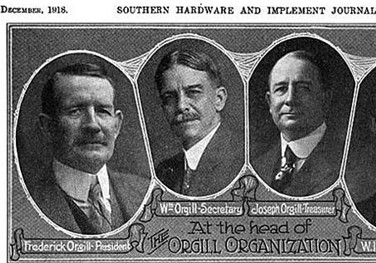
Brothers Frederick, William and Joseph Orgill
Edmund and Lucy returned to England on numerous occasions over the next 50 years. Indeed, one of their sons, Joseph, was born in Rugeley. When Edmund died in September 1905 at the age of 80, he and Lucy were in Leamington Spa, Warwickshire, perhaps visiting relatives of Lucy. Edmund was buried in Mavesyn Ridware churchyard. Lucy returned to Shelby County, Memphis, where she remained until her death in July 1923.
It was Frederick, Edmund’s eldest living son, who took over as president of the company in 1905. He understood the changing needs of the new 20th century and expanded the company’s inventory to accommodate inventions such as the motor car, electric lighting and indoor plumbing. In 1908 he decided to confine the Orgill Company’s activities to the wholesale trade and sold its retail arm to the De Soto Hardware Company.
In succeeding years, particularly the years of the First World War, the wholesale business developed so rapidly that in 1918 the volume was five times what it had been in 1897/8 at its incorporation. When Frederick died suddenly in October 1919, his brother William became the president of the company and it was he who began geographical expansion by setting up a subsidiary in Jackson, Mississippi, which in the 1920s was a hotbed of growth spurred on by the timber industry. William died in 1940.
In the next generation, Edmund’s grandson, William’s son, a third Edmund, steered the company through the product shortages of the Second World War and into the post-war boom years, recognizing the need to find new products to keep the hardware retailer ahead of their competitors. However, he also had strong political interests and was elected mayor of Memphis in 1955 and resigned his position as company president. During his mayoral administration, Edmund helped ease racial integration in Memphis. He was key in convincing the Memphis business community to peacefully de-segregate public places such as department stores, parks, libraries and eating establishments. When he resigned from the family business, it was his cousin, another of Edmund Snr’s grandsons, Joseph Jnr, to whom the presidency of the Orgill Company now passed. He continued the company’s policy of embracing new ideas and technology and in the early 1950s he stocked the latest ‘magic mirror’ televisions, automatic record changer players and radio phonographs. He also understood the need for distribution efficiencies and pioneered the idea of single-story warehouses, thus improving despatch speeds.
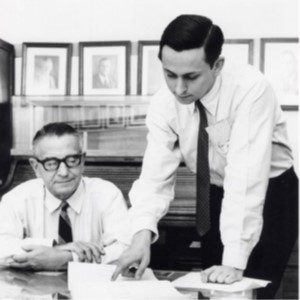
Joseph Orgill Jnr. and his son Joe Orgill III who guided the company as Presidents from 1955 to 1980.
In 1968 Joe Jnr resigned and the fourth generation, in the person of his son, Joseph Orgill III, took over the reins of this highly efficient company, as president of Orgill Brothers & Co. Times were changing rapidly and he knew there was no room for complacency in the face of stiff competition from a new kind of hardware distributor; the dealer-owned co-operative retailers. These large co-operatives brought small independent hardware companies under their banner and provided centralised marketing and purchasing services to them. Their combined buying power meant they were able to negotiate lower prices from hardware dealers and potentially damage the profits of their suppliers, such as the Orgills. Joseph III lost no time starting nearly five decades of change and expansion, remaining president until 1980. In 1979 he made a major decision. He decided the company needed professional management and so for the first time in over 130 years a non-family person took over as President. From this time he maintained close links to the company, remaining on the board until his death in 2018. He and his wife had four daughters. They are the fifth generation.
What is extremely unusual about Orgill Inc. is that after 174 years and five generations, it is still independent and the same family is still involved, albeit on the board of directors rather than actively involved in the day-to-day operations and decision making. Today Orgill Inc. is Memphis’s oldest and longest running business and also the nation’s largest independently owned hardware distributor operating over five distribution centres across the country. These centres distribute hardware, home improvement and building materials across the United States, Canada and to more than 60 countries across the globe. Throughout its span in history, Orgill Brothers has survived a civil war, two world wars, fires, yellow fever epidemics and the great depression without a break.
Over time the Orgill family came to regard themselves as American, and in 1927, Joseph Jnr, grandson of Edmund became a US citizen.
In August 1966 Revd Dewi Rogers, the then rector of Mavesyn and Hamstall Ridware Churches, received a letter from Joseph Orgill Jnr.
Orgill Brothers & Co. (founded 1847 by William & Edmund Orgill)
Memphis, Tennessee
Dear Sir,
Last month the writer had the pleasure and privilege of visiting the Church of St. Nicholas, Mavesyn Ridware and of seeing the graves of William and Edmund Orgill who are buried in the Churchyard. These two men are the founders of this business.
At a recent meeting the Board of Directors authorised the sending of a cheque for $100 to the Church for the work of the Church.
Yours very truly
Joseph Orgill Jnr. (President)
[Third generation]
Through the generations the Orgill family demonstrated a remarkable ability to know not only when to steer the company on a new course, but also what course to take – and it all began in Hamstall Ridware!
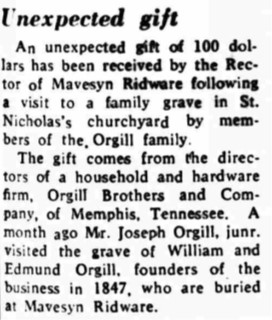

Helen Sharp
Sources
Celebrating 150 years of Tradition, Innovation and Service by Orgill. Inc. (Published 1997)
Memphis Daily Appeal May 11 1883
Porteous, Clark with additions by Adele Orgill. The First Orgill Century: 1847 to 1947. (Published 1948).
Southern Hardware and Implement Journal (December 1918) accessed 2018
The Hardware Connection. (Published 2018) accessed 2019
The Hardware Connection. (Published May/June 2019) accessed 2019
A fascinating tale, simply and clearly told. It’s wonderful to read of this enterprising, adventurous and clearly talented family’s successful part in helping to build what was in the mid-1800s still a New World!
Well done, Richard, for communicating the extensive Orgill family history starting in Hamstall Ridware. I am distantly related to the Anne Tarratt mentioned. I am particularly keen to research Joseph Tarratt and his family.
A clipper ship named ‘Joseph Tarratt’ was built in Canada in 1853, and transported numerous emigrants to Austalia from Liverpool over the next 10 years or so. It also achieved the fastest Transatlantic crossing to New York in 1856.